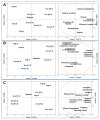Colonic In Vitro Model Assessment of the Prebiotic Potential of Bread Fortified with Polyphenols Rich Olive Fiber
- PMID: 33673592
- PMCID: PMC7997273
- DOI: 10.3390/nu13030787
Colonic In Vitro Model Assessment of the Prebiotic Potential of Bread Fortified with Polyphenols Rich Olive Fiber
Abstract
The use of olive pomace could represent an innovative and low-cost strategy to formulate healthier and value-added foods, and bakery products are good candidates for enrichment. In this work, we explored the prebiotic potential of bread enriched with Polyphenol Rich Fiber (PRF), a defatted olive pomace byproduct previously studied in the European Project H2020 EcoProlive. To this aim, after in vitro digestion, the PRF-enriched bread, its standard control, and fructo-oligosaccharides (FOS) underwent distal colonic fermentation using the in vitro colon model MICODE (multi-unit colon gut model). Sampling was done prior, over and after 24 h of fermentation, then metabolomic analysis by Solid Phase Micro Extraction Gas Chromatography Mass Spectrometry (SPME GCMS), 16S-rDNA genomic sequencing of colonic microbiota by MiSeq, and absolute quantification of main bacterial species by qPCR were performed. The results indicated that PRF-enriched bread generated positive effects on the host gut model: (i) surge in eubiosis; (ii) increased abundance of beneficial bacterial groups, such as Bifidobacteriaceae and Lactobacillales; (iii) production of certain bioactive metabolites, such as low organic fatty acids; (iv) reduction in detrimental compounds, such as skatole. Our study not only evidenced the prebiotic role of PRF-enriched bread, thereby paving the road for further use of olive by-products, but also highlighted the potential of the in vitro gut model MICODE in the critical evaluation of functionality of food prototypes as modulators of the gut microbiota.
Keywords: 16S-rDNA MiSeq; FOS; MICODE; VOCs; microbiota; olive byproduct; prebiotic; qPCR.
Conflict of interest statement
The authors declare no conflict of interest.
Figures




References
-
- Gibson G.R., Hutkins R., Sanders M.E., Prescott S.L., Reimer R.A., Salminen S.J., Scott K., Stanton C., Swanson K.S., Cani P.D., et al. Expert consensus document: The International Scientific Association for Probiotics and Prebiotics (ISAPP) consensus statement on the definition and scope of prebiotics. Nat. Rev. Gastroenterol. Hepatol. 2017;14:491–502. doi: 10.1038/nrgastro.2017.75. - DOI - PubMed
MeSH terms
Substances
LinkOut - more resources
Full Text Sources
Other Literature Sources
Medical

